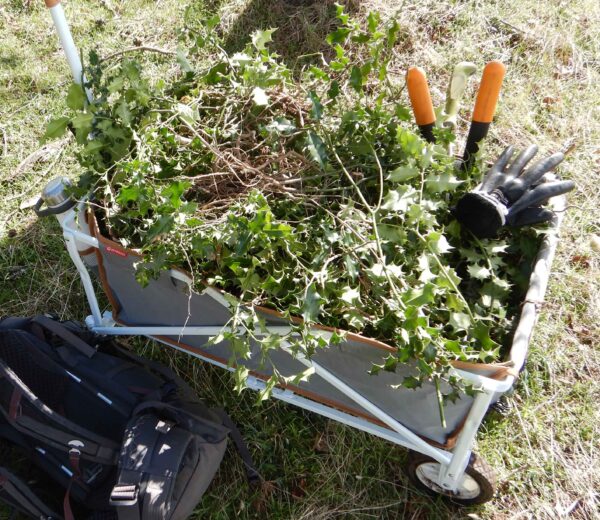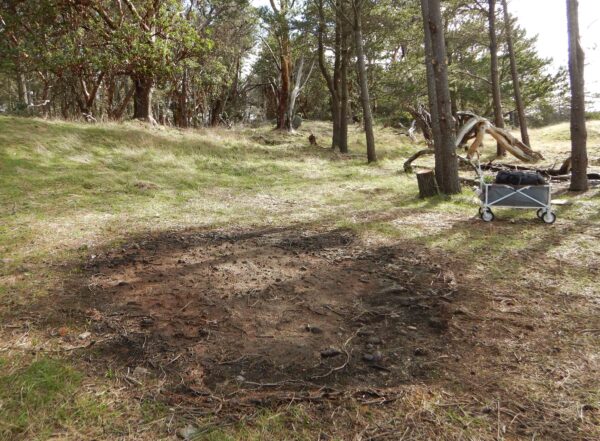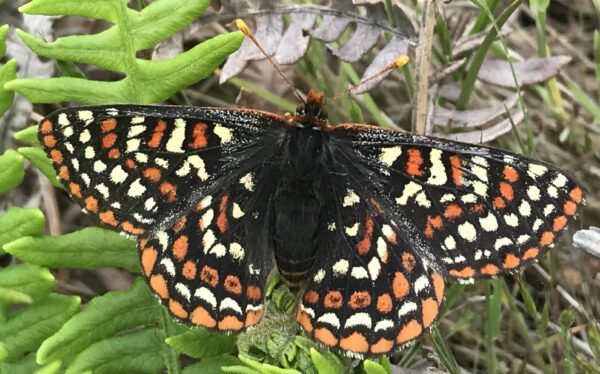Helliwell burning benefits butterflies?
By The Taylor’s Checkerspot Butterfly Recovery Project Team
It’s good to pause occasionally when pulling weeds. Stretch those tired muscles before they cramp up. Enjoy the sunshine. Find some endangered caterpillars.

Thistles, English Holly and other invasive plants were removed to help restore habitat. Photo by Kihan Yoon-Henderson.
That’s what happened in mid-March when Kihan Yoon-Henderson took a break while removing English Holly and Thistles from Helliwell Provincial Park’s coastal bluff habitat. She found more than 60 Taylor’s Checkerspot Butterfly larvae.

More than 60 Taylor’s Checkerspot Butterfly larvae were counted in Helliwell Provincial Park this spring. Photo by Kihan Joon-Henderson.
It’s the second consecutive year that the TCB Recovery Project Team can confirm that the endangered Taylor’s Checkerspots successfully overwintered in the park. The caterpillars were the offspring of butterfly larvae raised at the Greater Vancouver Zoo by Wildlife Preservation Canada staff and released in Helliwell in previous years. “This is great news and an encouraging sign that Taylor’s Checkerspot Butterflies are re-establishing a population in the park”, said Chris Junck, TCB Recovery Project Team Public Outreach Coordinator.

Native plant seeds are scattered on sites where piles of tree material were burned during the forest fire fuel reduction project. Photo by Kihan Yoon-Henderson.
The invasive plant removal work by Kihan and Hornby Island volunteers follows native plant seeding of sites where piles of tree material were burned during an ongoing multi-year forest fire fuel reduction project. Restoring burn sites and Garry Oak habitat on the bluff is intended to benefit butterflies and other pollinators. Hopefully, current butterfly counts will verify that the habitat restoration work is paying off.

Taylor’s Checkerspot Butterfly counts in Helliwell are continuing in June. Photo by Jennifer Heron.
Trampling is a key threat to Taylor’s Checkerspot survival. Helliwell Provincial Park visitors can help reduce this risk. Follow Park rules: leave bikes in the parking lot, stay on marked trails and keep dogs leashed.
The project team would like to thank the Cowichan Tribes, Halalt, Homalco, K’ómoks, Lake Cowichan, Lyackson, Penelakut, Qualicum, Snaw’Naw’As, Stz’uminus, Tla’amin, We Wai Kai, and We Wai Kum First Nations for allowing us to restore ecosystems in their traditional territories. Several local volunteers from Conservancy Hornby Island, the Hornby Island Natural History Centre, the Hornby Island Provincial Parks Committee, and others also contributed to the success of this project.
The recovery project has benefited from funding and in-kind contributions from the BC Parks Licence Plate Program, the Habitat Conservation Trust Foundation, the Environment Canada Habitat Stewardship Fund, and the B.C. Ministry of Environment and Parks (Ecosystems Branch), Canada Pollinator Partnership and others.
The Taylor’s Checkerspot Butterfly Recovery Project Team includes biological consultants and representatives from the B.C. Ministry of Water, Land and Resource Stewardship, B.C. Ministry of Environment and Parks, BC Parks, Denman Conservancy Association, Garry Oak Ecosystems Recovery Team, Greater Vancouver Zoo, Mosaic Forest Management, Wildlife Preservation Canada, and others.